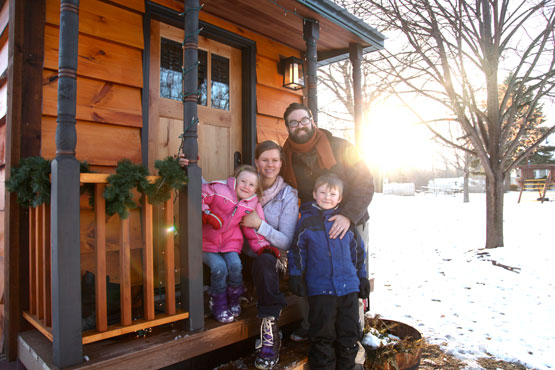
How do you fit a full-sized family into a tiny house? The Morrisons and Kasls found that the benefits of life in 200 square feet outweigh the difficulties.
Andrew and Gabriella Morrison live in Oregon and have two teenage kids, 18-year-old Paiute and 14-year-old Terra. They made the decision to downsize their home four years ago. They now live in a 207-square-foot house with an additional 110 square feet of sleeping lofts. Although their son, Paiute, no longer lives at home, Terra lives in the tiny house full time with her parents. The Morrisons both work in straw bale construction, and run the website Strawbale.com.
Across the country, in snowy Minnesota, Kim and Ryan Kasl have two young children, 6-year-old Sully and 4-year-old Story. The family of four is in the process of transitioning from their 1,900-square-foot home into a 207-square-foot tiny house. Ryan is embarking on a career in education administration, and Kim home-schools both their children. She also blogs about her family’s tiny house experiences.
Both the Morrisons and the Kasls can bear witness to the challenges of fitting a full-sized family into a tiny house. But, at the same time, they have found their own ways to make tiny living fit for them. Like a growing number of people across the country, they’ve found that the benefits of downsizing far outweigh the difficulties.
Going tiny
You’ve probably heard about tiny houses before. Maybe you’ve streamed the popular documentary Tiny on Netflix, or read one of the bazillions of tiny house articles published at YES! (like this one, this one, or maybe this one, published earlier today). All the media coverage has made simplified living a mainstream fantasy.
A lot of us are enchanted with the idea of tiny homes, but it’s still hard to view downsizing as a viable option: You’ve got too much stuff you wouldn’t want to part with; or you think you couldn’t fit kids in quarters less than 1,000 square feet. Moving into a tiny house probably isn’t too outrageous for most single twenty-somethings (in fact, it’s sort of a cooler, more equipped version of our recent dorm rooms). But is it possible to move into a tiny house as a family?
More and more families are doing just that—simplifying their lives by significantly cutting their square footage. The question is: why?
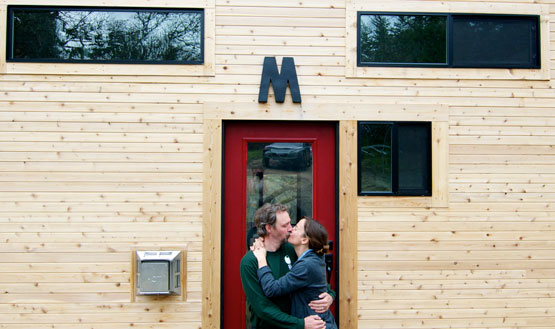 The Morrisons, of Oregon, moved into a 317-square-foot space with their teenage daughter. (Photo: Andrew Morrison)
The Morrisons, of Oregon, moved into a 317-square-foot space with their teenage daughter. (Photo: Andrew Morrison)
1. You save some cash.
“In the wake of the United States’ housing crisis and the overall global recession, the single-family home—once the celebratory site of domestic accomplishment—has become not a symbol of pride and freedom, but a prison of economic uncertainty,” wrote Mimi Zeiger in her book Micro Green: Tiny Houses in Nature.
The median home value within the US has gone up almost four times since the first housing census back in 1940, after adjustment for inflation.
“We used to live in what we thought was the perfect house. Then one day we started questioning what this ‘perfect’ house was costing us,” said Andrew Morrison. “We quickly saw that we were spending way too much money, and more importantly, too much time paying for a house that we didn’t need.”
Moving into a tiny house can help families avoid taking out a mortgage. And building a tiny home is significantly less expensive than building a conventional house today. Going tiny also means that bills for water, sewage, garbage, and electricity drop significantly. And, of course, you can’t fit much stuff into a tiny home. Less stuff to buy means more money in your pocket.
2. You save the planet!
“Beyond the cost, we saw that the environmental impacts of our house were bigger than what we wanted to live with,” said Morrison. Having worked in environmentally conscious “green” house construction for 20 years, Morrison set out to significantly decrease his own family’s impact on the environment.
The Environmental Protection Agency has estimated that between 2000 and 2050 global energy use will go up 300 percent. This drastic increase in energy and material consumption would put a huge strain on the environment.
“Houses that are smaller all-around require less material input as well as fewer equipment and labor hours to construct,” reads a study released by the EPA on the impact of single-family houses. “In addition, homeowners capitalize on using less energy to operate these smaller homes.”
3. And you just might save your sanity.
Living in a tiny house means having less stuff, fewer bills, and not as many living expenses, which means less time necessary to spend at work.
“I love that as Ryan climbs the ladder in his career we are not upgrading our home, cars, and ultimately, our debt,” explained Kim Kasl. “Instead we’re simplifying our lifestyle while upgrading our experiences and adventures. I want the weight of excess responsibilities and bills to be gone so we can be free to do awesome things together as a family.”
Your time becomes opened up for activities that make you happy, regardless of whether they make you money. And beyond giving you more time to spend with friends and family, tiny living often forces you to spend more time outdoors, which is proven to ease symptoms of depression and anxiety.
4. But does it really work?
That all sounds good. But then again, what if you live where it’s difficult to find an appropriate place to build your tiny house? Or someplace—like Minnesota, where the Kasls live—where the wind chill dips well below zero in the winter?
As cool as they can look in pictures like this:
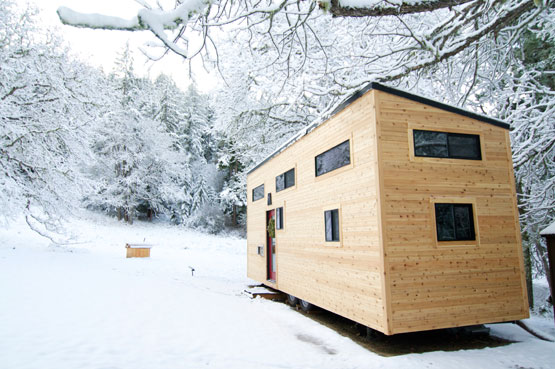 The Morrisons’ tiny house in an Oregon winter. (Photo: Andrew Morrison)
The Morrisons’ tiny house in an Oregon winter. (Photo: Andrew Morrison)
And this:
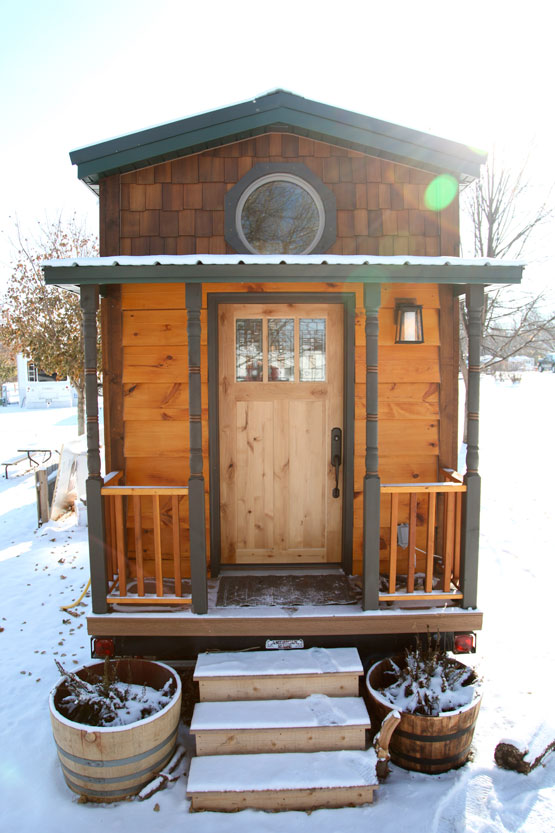 Not your average suburban home. The Kasls’ downsized house in suburban Minnesota. (Photo: Kim Kasl)
Not your average suburban home. The Kasls’ downsized house in suburban Minnesota. (Photo: Kim Kasl)
We still wonder: Can you actually raise kids in a 200-square-foot house? How do you cultivate personal space? Or have friends over? And as kids grow up, have sleepovers, hit puberty (and occasionally really want their own bedroom doors to slam in your face), is tiny house living even possible?
Here’s what we learned from the Morrisons and the Kasls.
How do you make the transition—especially with a bunch of people’s stuff?
According to Kasl, the secret to a successful transition for her family was taking baby steps. “When we knew for sure that we were going to build a tiny house, everything started gradually,” she explained. “We ‘moved’ downstairs first and brought everything we needed with us. That left the rest to be easily sifted through, boxed up, and shipped out.”
After moving downstairs, Kasl’s family moved back upstairs and went through the process again. After a couple of moves within their home, they were able to differentiate between items they actually needed and ones they could do without.
When considering whether we could try tiny living or not, many of us have questions about our stuff. What are you supposed to do with all your furniture, clothes, kids’ toys, and books? What if your hallway closet alone would pack a tiny house to the gills?
“The key to designing my happy home … lay not so much in deciding what I needed as in recognizing all the things I can do without,” wrote Jay Shafer in The Small House Book. Shafer owns Tumbleweed Tiny House Company, which has been designing tiny houses since 2002. “What was left over read like a list I might make before packing my bags for a long trip.”
And don’t feel bad if there are a few things you can’t part with. The idea behind simple living isn’t to cast off all of your material possessions; it’s to simplify your possessions down to stuff that really matters. If you’ve got something that won’t fit in your tiny house but you don’t want to part with, get creative. Ask friends and family if you can store something at their place. Or consider renting a small storage unit.
“The one thing we refused to get rid of was our collection of books,” said Kasl. “We just keep a bookshelf at our grandparents’ homes and swap books out for fresh ones when we visit.”
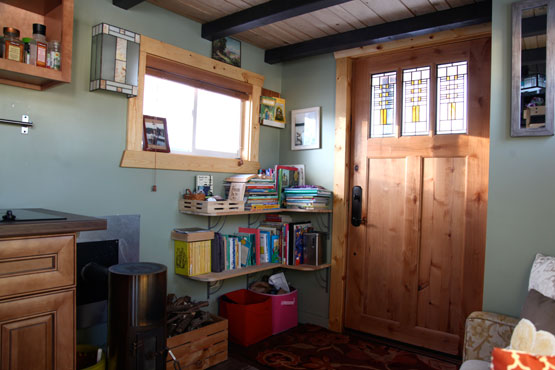 The kids’ corner. They keep a backup library at Grandma’s. (Photo: Kim Kasl)
The kids’ corner. They keep a backup library at Grandma’s. (Photo: Kim Kasl)
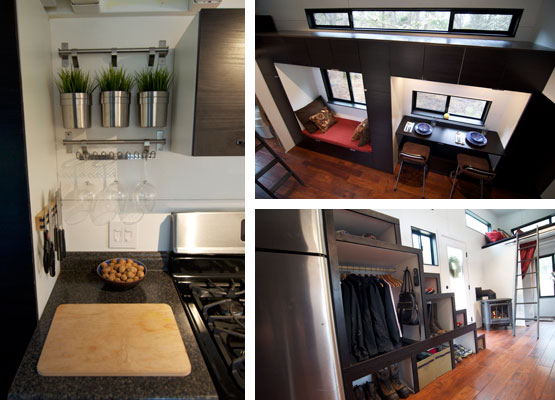 With a smaller living space, the Morrisons are mindful of what they keep in their house. (Photo: Andrew Morrison)
With a smaller living space, the Morrisons are mindful of what they keep in their house. (Photo: Andrew Morrison)
What about having company over?
Hosting a full-sized party in a tiny house is, obviously, impossible. However, that doesn’t mean you have to give up entertaining altogether.
“Having large indoor parties is not really an option,” explained Morrison. “We’ve adjusted for that. We built outdoor gathering spaces: a fire pit, an outdoor dining area, a wood-fired hot tub, and guest cabins.”
That’s right: guest cabins. Extra tiny houses!
Put some thought into what types of gatherings you and your family enjoy hosting. Do you like having friends and family spend the night? Have fun throwing large dinner parties? Create social spaces outside of your home that make sense for your family.
“We’ve made it work by designing and building a space that fits our needs,” Morrison said. “We built this tiny house specifically for our family, and because of that every need we have is met.”
An added bonus: If you hate hosting parties at your place, you’re officially off the hook.
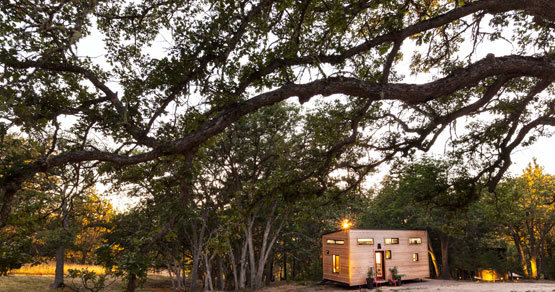 The Morrisons cultivated plenty of outdoor space for social gatherings around their house. (Photo: Andrew Morrison)
The Morrisons cultivated plenty of outdoor space for social gatherings around their house. (Photo: Andrew Morrison)
Do little kids like it?
“Everyone wants to know if they should really do it,” Kasl told me. “They want to build a tiny house but they hesitate because of the kids. Most people expect that kids will have a hard time transitioning into a tiny house.” Kasl often surprises people by explaining how much her kids enjoy living in their tiny house.
“They love everything that has to do with our new lifestyle. Seriously. No exaggeration at all,” said Kasl. Since her family is still in the process of moving out of their old home, she and her kids often stop by to finish up the cleaning and prepare it for sale. She says her kids don’t even want to go back into their old house. “They want to get back home to the tiny house as quick as they can.”
There’s been no mention of the toys that were lost in the tiny transition or the bedrooms that no longer exist. And, perhaps because of the adventurous nature of their new home, her kids are more eager than ever to help with chores like cleaning, cooking, and gathering firewood.
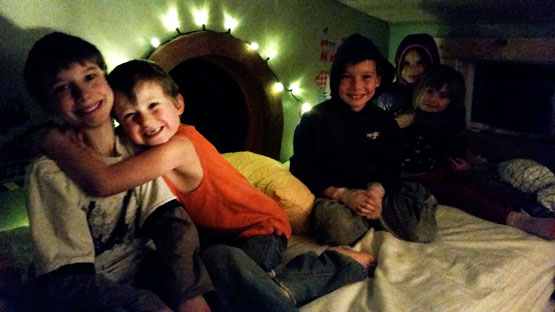 The Kasl kids rearranged their room to make space for a party with their neighbors. (Photo: Kim Kasl)
The Kasl kids rearranged their room to make space for a party with their neighbors. (Photo: Kim Kasl)
OK. But what about teenagers?
Tiny living with young kids is one thing. They’re small, they are easily distracted, and they usually don’t care too much about personal space. But what happens when your kids turn into teenagers?
Morrison and his wife live with their teenage daughter, Terra. One of the main motivations behind the couple’s decision to go tiny was their desire to grow closer as a family. And, since switching to tiny living four years ago, Morrison said his family has indeed grown much closer.
“Living tiny requires people in the home to communicate and not run away from difficulties,” explained Morrison. “That’s not to say we don’t still have family clashes from time to time. It just means that when that happens we have a framework to move through it.”
The cabins that Morrison built for overnight company double as a teenage escape. “They are great private spaces for the kids if they want to get away,” said Morrison. “They can use them to have some time to themselves, do school work, or have friends spend the night.”
And although Kasl’s children are still young, she already has a plan for when teenage angst could start creeping into their home. “We are looking forward to a big high school project of helping each of the kids build their own tiny houses,” explained Kasl. “Building their own houses will give them an opportunity to gain construction skills, learn how to be self-sufficient, and give them the option of starting a life with mortgage freedom.”
What teenagers wouldn’t love having their own personal tiny houses?
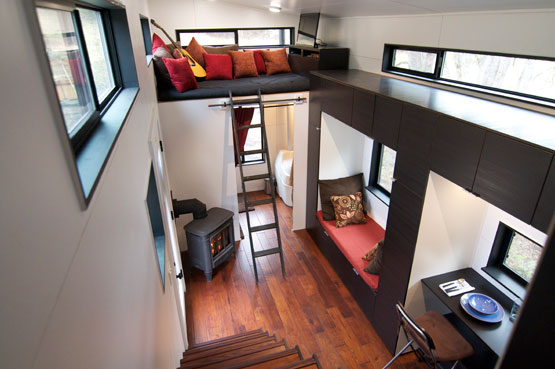 The Morrisons designed nooks for alone time, for them and their teenage daughter. Here, they lounge in their own private spaces. (Photo: Andrew Morrison)
The Morrisons designed nooks for alone time, for them and their teenage daughter. Here, they lounge in their own private spaces. (Photo: Andrew Morrison)
What if you’re home-schooling in your house?
The Morrisons and the Kasls have home-schooled their kids while living in their tiny homes. At 14, Morrison’s daughter is rather self-sufficient when it comes to her education. She loves learning and is motivated to get up and do her schoolwork.
Kasl, on the other hand, has two small children. She says her home schooling technique revolves around one thing: getting out as much as possible. “Reading, playing outside, and taking advantage of new experiences is the basis of the kids’ education,” explained Kasl.
“We learn in our tiny house but also on nature walks, on field trips with our church’s home school co-op, at the children’s theater and the science museum, in Papa’s garage building birdhouses, in Nana’s sewing room making mittens, and at their uncle’s farm meeting baby animals and riding horses.”
Kasl credits her tiny house for helping to improve her kids’ education. With fewer household responsibilities, she has more time to devote to teaching. And having less space has encouraged her to be more creative with daily activities.
“Of all the reasons we chose to live in a tiny house, home schooling is definitely one of them,” said Kasl. “People think it poses such a challenge, but the tiny house is actually an enabler.”
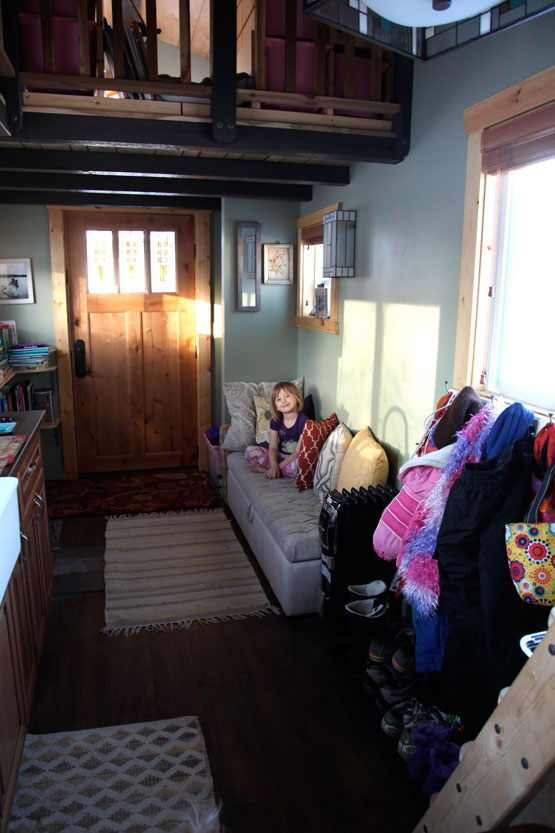 The Kasl kids say they love learning at home. (Photo: Kim Kasl)
The Kasl kids say they love learning at home. (Photo: Kim Kasl)
How do you keep warm?
Not every tiny house can be parked on a beautiful, sunny beach. So, how can you cope with snow and below freezing temperatures?
Kasl admits that preparing for a long Minnesota winter has been a challenge. “We didn’t really anticipate all of the winter preparations that have to be made in a tiny house,” she said.
And preparations go far beyond finding and storing firewood for their wood-burning stove.
“There’s electric heat tape on the plumbing under the trailer so our water doesn’t freeze,” explained Kasl. “And, to keep the heat from escaping, Ryan and my dad skirted the trailer with some sheets of insulation.” The sheets of insulation double as a storage area for Kasl and her family, where they can keep bikes, summer toys, and tools.
What about being cooped up in 200 square feet all winter long?
“I think anyone who stays inside all winter might go a little crazy, no matter the size of their house. We plan on getting out,” said Kasl. And, when at home, her family has embraced the new list of chores and responsibilities that winter has brought. “It feels like a vacation: peaceful, simple, exciting,” she said. “We love it completely.”
 No one’s supposed to stay inside their house all the time anyway. To stay sane, the Kasls bundle up and get out as much as they can in the winter… (Photo: Nichole Freiberger)
No one’s supposed to stay inside their house all the time anyway. To stay sane, the Kasls bundle up and get out as much as they can in the winter… (Photo: Nichole Freiberger)
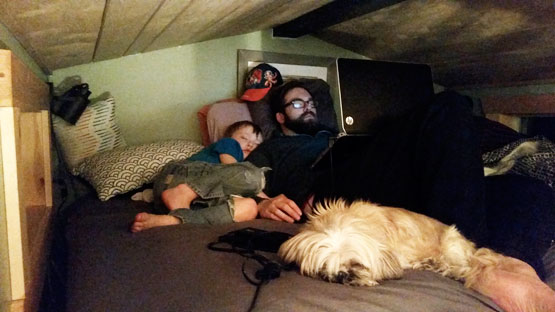 …and snuggle up for long winter nights. (Photo: Kim Kasl)
…and snuggle up for long winter nights. (Photo: Kim Kasl)
Interested in learning more about downsizing your home? Check out these online tiny house classes designed to teach families how to make the transition for themselves.
Join us in defending the truth before it’s too late
The future of independent journalism is uncertain, and the consequences of losing it are too grave to ignore. To ensure Truthout remains safe, strong, and free, we need to raise $27,000 in the next 24 hours. Every dollar raised goes directly toward the costs of producing news you can trust.
Please give what you can — because by supporting us with a tax-deductible donation, you’re not just preserving a source of news, you’re helping to safeguard what’s left of our democracy.